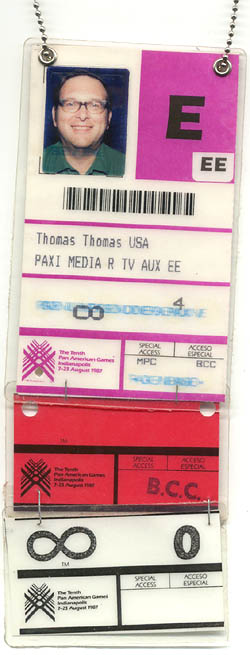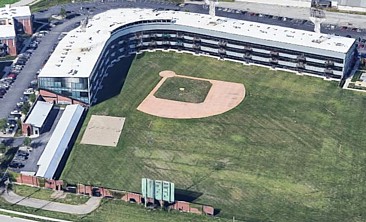Indianapolis
1987
Written September
8, 2003
Cruzeiros updated
August 5, 2016
My life in television had become rather complicated by the summer of 1987. I was traveling hither and yon, working on a freelance basis as well as for my regular employer, TCS Productions.
The chaos peaked in the middle of August. In case anyone's interested, I've reconstructed the details.

At the Pan American Games, held in Indianapolis from August 7 through 23, TCS handled most of the Host Broadcaster duties.
Our base of operations was in the conference center at "Ooey-Pooey." That's how folks pronounced IUPUI, the initials of Indiana University-Purdue University Indianapolis.
We provided services to CBS Sports, which telecast 26 hours of coverage in this country, as well as to broadcasters from the 37 other participating Western Hemisphere nations.
For example, Brazil was there. A couple of Brazilian execs took some of us to dinner one evening — was it at St. Elmo Steak House? — and actually passed out money as souvenirs. Brazil’s inflation rate was over 200% a year, so any currency soon became almost worthless.
|
|
The execs handed me this 100,000-Cruzeiro note (overstamped “100 Cruzados” as a result of the previous year’s devaluation). According to the official exchange rate, at the time the note was worth only $2.23 American. |
The next seven years saw more changes to Brazil’s financial system, eventually resulting in a new currency called the Real. It was introduced as the equivalent of a U.S. dollar and valued at 2.75 billion Cruzados — or 2.75 trillion Cruzerios. By late 2015, it was worth only about a U.S. quarter. That makes my 100,000-Cruzeiro note theoretically worth less than a millionth of a penny. Moral: Don’t store your paper money under the mattress.
At the time, TCS also had other continuing projects not connected with the Pan Am Games. For example, I was the producer of our weekly Penn State Football highlights program. The first program of the season would be a show reviewing the previous year, our National Championship special. It was scheduled to be transmitted to TV stations and to ESPN (in a slightly different version) on August 2, a date that would be eventually be pushed back ten days.
So on July 29 and 30, before we left Pittsburgh, Jack Sedlak and I put this show together except for some commercials that would be sent to us later. Then, after a high-school all-star football game on August 1, I packed the tapes and my computer and printer in my car on Monday, August 3, and made the long day's drive west.
|
|
I checked in at the Howard Johnson's Motor Lodge near the Indianapolis airport. The next day, I went downtown to get my credentials for the Pan Am Games. TCS still had not fully determined what I was doing there. Other people were running around like crazy, but not yours truly. At first, I hung around the broadcast center, doing some minor tape editing. The opening ceremony was held at the Indianapolis Motor Speedway on Saturday, August 8, where our TCS mobile units are seen parked below. Tom Huet suggested that I go out to watch some of the Disney-produced gala from the infield. More interested in the racetrack than the ceremony, I wandered from the north pits up to Turn Four.
|

Jack got a ride in the Goodyear blimp in order to shoot some aerial footage of the city; I drove out to the airport to pick him up when the blimp landed.
On Tuesday, August 11, he and I went to the soccer venue before the day's competition began. In the production truck, we edited those final commercials into the Penn State show, which was uplinked from the broadcast center the following day.
|
Lou Rainone was directing the video portion of the international baseball coverage. For the audio portion, each Latin American country that wanted to televise baseball provided its own announcers. Tom sent me out to Bush Stadium a few times, but I didn't really have much to do. I hung out in the truck, highlighted here in yellow. |
|
|
Incidentally, that same year Bush Stadium stood in for two older ballparks during the filming of a movie about the 1919 Black Sox scandal, Eight Men Out.
|
Later in the month, things started happening — elsewhere. I had already been a graphics operator for two CART races produced by Don Ohlmeyer for NBC, most recently in New Jersey in May. Another one was coming up, the Pocono 500, so TCS decided to send me there. I flew to Wilkes-Barre, Pennsylvania, on the evening of Thursday, August 13, and got a room at the Holiday Inn. Now I had two hotel keys in my pocket.
After the race on Sunday, won by Rick Mears, I flew back to Indy on Monday for another six hours of work on the Pan Am games. But then I was off again.
Starting in April of that year, I had been traveling with the Pittsburgh Pirates for KDKA-TV. I had already worked 26 telecasts on a freelance basis, and now, by prior arrangement, I drove down to Cincinnati to work three more: Pirates at Reds on Tuesday through Thursday of that week, August 18 through 20. Once again I had two keys.
I returned to the Pan Am Games on Friday. TCS now had decided to have me work as a graphics operator for CBS on the final weekend. On Saturday I'd be at the gold medal game in baseball, and on Sunday the gold medal match in men's volleyball.
Both events, as it turned out, featured the United States versus Cuba, two nations that were not on the best of terms. Incidents had broken out at the boxing venue, and there was some fear of violence — we didn't know what — at the events I was to work.
The baseball final on Saturday, August 22, began at 2:00 under threatening skies. We were still in the first inning when there was a loud noise. CBS play-by-play announcer John Dockery said that it sounded like a bomb had gone off. But in the production truck, we knew what had happened: a lightning strike, very close. Our monitors blinked, and someone sitting near me claimed to have seen a spark jump from my fingers to my keyboard.
Most of our equipment recovered, but my Chyron character generator was dead. The engineers worked on it for a while, then gave up. It couldn't be fixed. There were no further loud noises, but CBS had to provide graphics from their studio for the rest of the game, which was won by the favored Cubans.
(For another moment from that afternoon, click here.)
The next afternoon, Sunday, I was on the Butler University campus at Hinkle Fieldhouse, where the movie Hoosiers had been filmed two years before. The men's volleyball final started at 3:00. Everything went smoothly, except that CBS had to leave the air at 5:00, before the competition was over. At the time, Karch Kiraly and the United States team led the best-of-five match.
|
> USA |
15 |
15 |
15 |
. |
. |
|
CUBA |
12 |
7 |
17 |
. |
. |
Our CBS crew was long gone by the time the USA eventually won the gold medal in five games.
|
The closing ceremony was to be held that night at the Hoosier Dome (now the RCA Dome). Of course, it featured the official mascot Amigo, as well as Cuban expatriate Gloria Estefan and the Miami Sound Machine. Tom thought that we all ought to attend that ceremony, too, but as my services were not required, I went back to the Howard Johnson's and watched it from there. On Monday, I made the long drive back to Pennsylvania. I left at 10:30 AM EST, stopped twice to eat, and arrived at 8:15 PM EDT. The next day, I had to turn my attention to editing the Penn State preseason show. |
|
What I didn't know then was that this busyness was about to come to a close. On October 16, TCS declared bankruptcy, and by the end of the year I had become a full-time freelancer. No longer subject to being assigned to jobs, for the rest of my career I would work on my own schedule.






